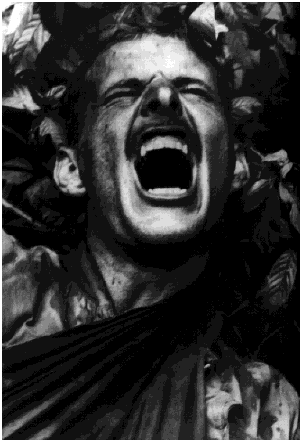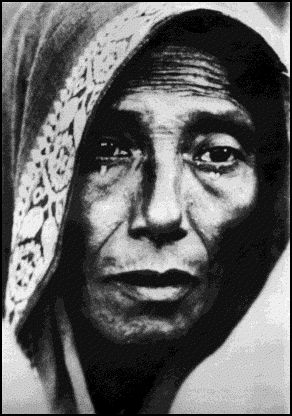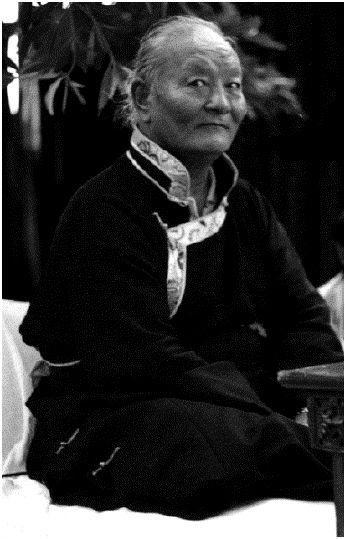Under
Fire
The World of the
War Photographer
Peter Howe
(Artisan)

He doesn't shy away from bodies in color, blood and all. One photographer, Patrick Chauvel, tells of not only shooting the war in El Salvador and Panama, but of being shot --- by mistake by a member of the 82nd Airborne ---
I looked like an idiot with a hole in my stomach and this dumb camera. I thought the Americans wouldn't pick me up when they saw it. "I'm press," I'd say. "Bullshit," they'd say. "No way. You're a tourist." It would have been terrible to die with that camera.
In another case, Maggie Steber (Haiti, 1987) gives us grisly photographs of fighting mixed with triumphal shots of the victors in the Presidential Palace at Port-au-Prince.
Philip Jones Griffiths took all his in black-and-white, mostly in Vietnam --- pictures of peasants in the rice fields, a couple of R&R brothel shots, and a ghastly picture of a Vietnamese woman with a dead child in her arms. ("Every photographer dreams of being invisible," he notes.)
Don McCullin also chooses to shoot in black-and-white which --- to my eye --- evokes a more subtle kind of horror. It is a matter of contrast and starkness to fit the subject. Also blood comes up black --- thus at one moment more strange and more ominous.
There are people weeping, military storming the streets of Ireland, Marines throwing grenades in Hue, bodies after the Tet offensive, and Congolese prisoners "about to be executed." McCullin, like the other photographers represented here, has something to say about the morality of it all. Early on, he took up photography "to get recognition."
I went to war and photographed other people's wars, but when I came away from them I needed to rehabilitate myself. I don't believe you can go to war as a photographer without some compassion in you.
And we are looking at these three young Congolese men and we know as McCullin knew that moments after he took the photograph they would be dead, shot through head or heart.
It has to be weird. We all recall the great photographs that we've looked at again and again, one taken in mid-1941, the day the Germans marched into Paris, a picture of a man, a man with a prosiac face, maybe he is a cab driver, or a lawyer, or a street-sweeper, or some provincial government official --- and he is weeping. We know why he is weeping, but we wonder about those who go around sticking their cameras in people's faces to catch a dramatic shot of someone in grief.
Maybe someone's sad because he or she has just lost a war; maybe there's a shot of a woman who has just lost a child; perhaps we have the face of a young black man who is scared shitless because he knows that he is about to die. And you ask yourself "If I were a photographer would I be shoving my camera into the face of someone in such trauma? If so, how would I be affected by what I am recording?"
I mean, does one just walk away from it and say, well, that's what people do: they get hurt and they die and they cry and I'm just recording history, it's my job to shoot it and not sit down and worry about the morality of it all.
This came up as I was leafing through Shooting Under Fire because there is a picture here by McCullin of some skeletal boys in Biafra --- they can't be more than ten or twelve years old --- who are obviously starving to death, three very young men dying because there isn't enough food to put in their mouths, dying not unlike those who went through Buchenwald; and this photograph is taken by someone who isn't starving, indeed, who will be flying out of there the next day on an army transport. What does he think?
Fortunately, the editor has given these photographers space to reflect on this and McCullin's words show him with the consciousness not of someone just doing a job, but one who shows some humanity, some regret or morality or sense of the horror of it:

- The difficulty of photographing scenes like this is that it calls into question your commitment. What can I achieve by taking pictures of starving children? What kind of a risk am I taking here? What am I giving back here? I'm taking, but I am not giving. If you photograph a person who's dying, you're not going to save that person's life, and you start having all these things go through your head that could wind up sending you mad. I took a photograph of an albino boy there. I photographed him and just walked away, but he followed me and held on to my hand. Every time I'm in the darkroom and that image comes up through the developer, it's a haunting experience. I rarely print that picture. That boy and many people in those images did not survive, and you say, How can I justify this? But how can I not do it? You're trapped in a no-win situation. You want to go out there and bring attention to what's happening so that others might be saved. But you are not going to save that boy, so whatever your achievements are, however small or large they may be, you still walk away with a slight crime on your hands.
Transformation,
And Dream Yoga
Venerable Gyatrul Rinpoche
(Snow Lion)
The chapter on meditation encompasses sitting in the right posture, closing the eyes, and trying to get the mind to mind its own business. However, the writing is not without some strange business of its own:
It may occur to you that there are two processes occurring: that of apprehending the mind and that of apprehending the apprehender. If you notice this, then allow the apprehender to look at the apprehending mind, which is like observing one's own face directly without anything else in between ... Then you will realize that the object being apprehended by the apprehender and the mind apprehending it are all indivisible...
The second part, having to do with dreaming, comes a little clearer. The work we must do is twofold. Realize that sleeping dreams are little different than the waking dream we call reality. We can thus induce the conscious mind to enter into our dreams so we can manipulate events:
Practice moving gross and subtle appearances of sentient beings and the environment back and forth; increase one to many; gradually reduce many to one; transform pillars and pots and so on into living beings, both human and animal; within the environment and its inhabitants change living beings into pillars, pots and so forth just as you please; transform the peaceful into the wrathful and the wrathful into the peaceful...
This puts one in mind of the Senoi of the South Pacific who, upon waking, would tell their dreams to family and friends. This included teaching the young to enter their dreams to alter the events. If one is being chased by a monster, one stops, turns to the fiend, and demands a gift. (It also put me in mind of my friend George Tobi who dreamed there was a bear trying to push open the door to his cabin to get in and eat him. George was pushing against the door with all his might when the alarm clock went off and he thought, "How am I going to shut off that alarm and keep the damn bear out at the same time?")
 The strangest section of Meditation, Transformation and Dream Yoga has to do with adversity. The author advises us that pain and trouble and the agony of living are "an aid to your spiritual practice." He says that it is vital "that you cultivate a strong and continuous sense of gladness," repeating,
The strangest section of Meditation, Transformation and Dream Yoga has to do with adversity. The author advises us that pain and trouble and the agony of living are "an aid to your spiritual practice." He says that it is vital "that you cultivate a strong and continuous sense of gladness," repeating,
Such adversity is a great help to me in experiencing the many, wonderful joys of the higher realms that lead to liberation, which are extremely difficult to reach ... Even if my suffering is severe, it is extremely agreeable, like ladu, a sweetmeat the taste of which is both sweet and hot.
I dunno. It's the equivalent of the Christian saying, "God would never send you nothin' you can't handle." If you were to tell that to my friend Karen, recently diagnosed with breast cancer, husband just out the door with the secretary --- tell her that she should view her troubles like a sweetmeat --- I am guessing that she would tell you to take your ladu and stuff it.
This doesn't mean that all of Gyatrul Rinpoche's thoughts are without merit. He tells a winning story of the yogin practicing meditation in the charnel grounds and a thief comes along and chops off his head. The meditator "deeply involved in the unity of appearances and emptiness"
thought that this was just a false apparition manifesting as an obstacle. Without a second thought he just reached down, picked up his head and placed it back in position while he continued on with the practice ... When his meditation was complete, he put his instruments away and went back home.
A few days later the Yogin ran into the thief who was, needless to say, agitated. He went up to the master, prostrated himself, and confessed what he had done.
With that thought, the yogin's head fell off and he died.
John Katzenbach
(Ballentine)
An aggrieved ex-client makes contact through the usual mysterious unsigned letter. In fifteen days --- so says his mysterious correspondent --- Dr. Starks must commit suicide. If he doesn't, one of the innocent members of his family will get snuffed.
Weird things start happening to him. He mysteriously loses his bank and brokerage accounts. The coöp apartment he owns gets trashed. A letter is sent to all of his clients and all the members of the local professional group, accusing him of philandering on the job. In this day and age, if you want to punish your shrink, simply send out letters accusing him or her of acting in an unprofessional manner on the counseling couch.
All of Starks' important papers disappear. He seeks out a policewoman for help and she gets murdered. And after a late night visit, his old psychoanalyst --- the one that analyzed him while he was in residency --- gets in a wreck. He begins to think that he's the modern version of Typhoid Mary, that all the people he turns to for help are going to end up in the grave.
His pursuer --- who calls himself Rumplestiltskin --- is assisted by a lovely lady named Virgil and a creepy lawyer named Merlin. They appear and disappear at Starks' side almost at will. As the fifteen days wind down, Rumplestiltskin sends successive messages in awful rhyme --- but Starks is allowed to ask three questions (also in awful rhyme) via the New York Times and the Village Voice.
When all is destroyed --- his practice, his two houses, his assets, his complacency, his self-confidence, his self-respect --- Starks goes underground. He pretends to kill himself, moves to New Hampshire, takes on a new identity --- a man named "Lively."
Out of the hundreds of novels that come into our offices every year, we probably get three or four that take you over, won't let you alone until you are done with it. This is one. I started The Analyst at the airport waiting for a stupid airplane which had been stupidly delayed, so it was the perfect time for me to do something besides twiddling my thumbs and cursing Homeland Security. Within a few minutes of diving into The Analyst, I was suddenly all too willing to wait for my flight. The subsequent four hours I was in the air zipped right by. Katzenbach took me over --- even made me a little paranoid: was that cheerful fat guy sitting next to me reading my notes? The thin guy behind me --- was he going to trash my bank account while I was off in the bathroom?
The Analyst reminds me of two of my most favorite chiller- Katzenbach is good with dialogue, especially with all the bureaucrats and clerks that one has to deal with. He is also good at doing the onion treatment on the doctor --- slowly peeling away all the tools that we use to protect ourselves from gossip, poverty, the world, and, ultimately, dying. When Starks reaches absolute zilch, he stalks an alky street-bum to steal his Social Security number and start all over again. From this nadir, the stalkee (Dr. Starks) becomes the stalker (Mr. Lively). The classical references (Odysseus, Dante, Virgil, Lazarus, Ulysses, Merlin) might get to be a bit too much, but they do help one remember who is who. The pacing and the sheer adventure of it all makes us bleary just wanting the damn thing to resolve itself or --- at the same time --- not wanting it to end at all.